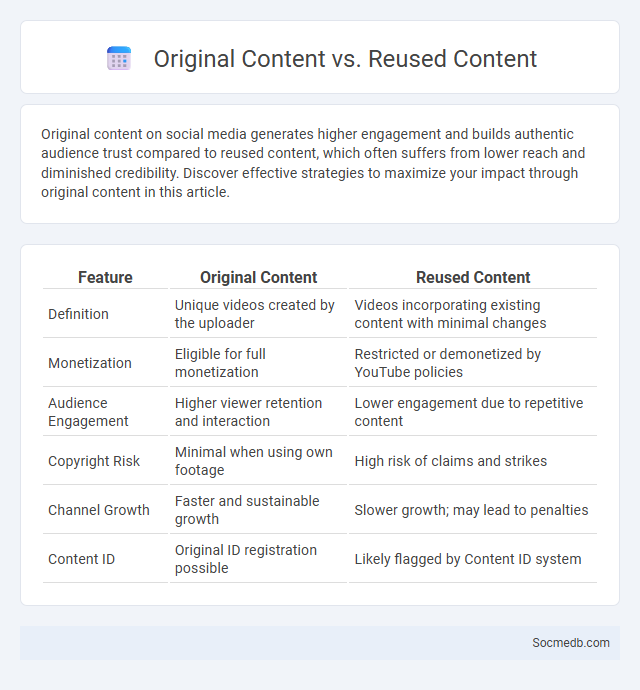
Photo illustration: Original Content vs Reused Content
Original content on social media generates higher engagement and builds authentic audience trust compared to reused content, which often suffers from lower reach and diminished credibility. Discover effective strategies to maximize your impact through original content in this article.
Table of Comparison
| Feature | Original Content | Reused Content |
|---|---|---|
| Definition | Unique videos created by the uploader | Videos incorporating existing content with minimal changes |
| Monetization | Eligible for full monetization | Restricted or demonetized by YouTube policies |
| Audience Engagement | Higher viewer retention and interaction | Lower engagement due to repetitive content |
| Copyright Risk | Minimal when using own footage | High risk of claims and strikes |
| Channel Growth | Faster and sustainable growth | Slower growth; may lead to penalties |
| Content ID | Original ID registration possible | Likely flagged by Content ID system |
Understanding Original Content: Definition and Importance
Original content on social media refers to unique, authentic posts created by users rather than copied or recycled material, which enhances engagement and builds trust with followers. Understanding the importance of original content helps brands and influencers establish a distinct voice, improve algorithm ranking, and foster genuine connections. Prioritizing originality also mitigates copyright issues and boosts long-term audience loyalty across platforms like Instagram, TikTok, and Twitter.
What Constitutes Reused Content?
Reused content on social media refers to any material that has been previously published and is shared again without significant modification or original input. This includes reposting images, videos, or text from other users or your own past posts without adding new context or value. Ensuring your content is fresh and unique helps maintain engagement and prevents your audience from perceiving Your brand as unoriginal.
Copyright Claims: An Overview
Copyright claims on social media protect original content creators from unauthorized use of their work, ensuring your digital creations remain secure. Platforms use automated systems like Content ID on YouTube and Rights Manager on Facebook to detect and manage copyright infringements efficiently. Understanding the takedown process and dispute mechanisms empowers you to safeguard your intellectual property effectively.
The Legal Implications of Content Creation
Creating content on social media carries significant legal implications, including copyright infringement, defamation, and privacy violations that can result in lawsuits or fines. You must ensure that your content respects intellectual property rights and avoids misleading or harmful information to comply with evolving digital laws. Understanding platform-specific policies and local regulations helps protect your brand and maintain credibility in the social media landscape.
SEO Impact: Original vs Reused Content
Original content on social media platforms significantly improves SEO rankings by increasing engagement metrics such as shares, comments, and time spent on page. Search engines prioritize fresh, unique content that provides value to users, boosting visibility and organic traffic. Reused content often leads to lower search engine rankings due to duplicate content penalties and diminished user interest.
Best Practices for Creating Original Content
Creating original content on social media requires understanding your target audience's preferences and delivering unique, valuable insights that resonate with them. Utilize high-quality visuals, authentic storytelling, and consistent branding to enhance engagement and foster trust. Regularly analyze performance metrics to refine content strategies and maintain relevance in a rapidly evolving digital landscape.
Risks Associated with Reused Content
Reusing content on social media can lead to copyright infringement issues, damaging your brand's reputation and resulting in potential legal consequences. Your audience may perceive reused content as unoriginal or spammy, reducing engagement and trust. Consistently sharing unique and authentic content is crucial for maintaining credibility and avoiding penalties from social media algorithms.
How to Avoid Copyright Infringement
To avoid copyright infringement on social media, always seek permission before using copyrighted images, videos, or music from original creators or licensed platforms. Utilize royalty-free resources and properly attribute content when required under Creative Commons or similar licenses. Regularly review platform-specific copyright policies, such as those from Facebook, Instagram, and YouTube, to ensure compliance and prevent content removal or legal penalties.
Tools for Detecting Copyrighted or Duplicate Content
Advanced tools for detecting copyrighted or duplicate content on social media include platforms like Copyscape, TinEye, and Content ID by YouTube, which scan posts and videos for unauthorized use. These tools leverage AI and machine learning algorithms to identify exact matches and similar content, helping creators protect their intellectual property. By using such technology, you can efficiently monitor your brand's online presence and prevent unauthorized content sharing.
Protecting Your Original Content Online
Protecting your original content online requires effective use of digital rights management tools and watermarking techniques to prevent unauthorized use or theft. Implementing clear copyright notices and regularly monitoring platforms through reverse image searches or plagiarism detection software helps identify infringement promptly. Engaging in proactive community reporting and understanding platform-specific content policies strengthens your control over the dissemination of your work.
 socmedb.com
socmedb.com